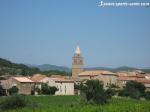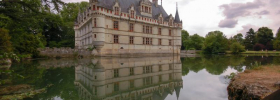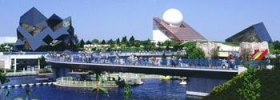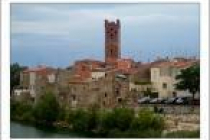 Home
Home- > Tourism France
- > Languedoc-Roussillon
- > Pyrénées-Orientales
- > Rivesaltes
Tourism Rivesaltes
Our earliest ancestors are Ligurians sixth century before Christ, which had its capital HELICE (Narbonne), and (Elne) Pyrene The Ligurian, residing on the current site of the Rivesaltes is called "Sordons" (village Sordinia) currently Opoul. They were driven by Iberians fourth century BC From Libya and Egypt, Rivesaltes bears the name of Ripis Altis and its people as Bébryces. The Romans had fortified a move to ford to protect an alternative route when the swamps of the Salanque rendered impassable the Via Domitia, at the time the "Ripas Altas' became a necessary route to cross the Roussillon. The Chapel of St. Andrew retains the testimony of the Iberians, Romans and Visigoth under a slab of glass. However, the first written historical Rivesaltes date from the year 923 when the Sieur LANDRIC donated his property, vineyards, homes and mills Abbey LAGRASSE in the Aude. It should be remembered that before the signing of the Treaty of the Pyrenees in 1659, Lagrasse is in France and Rivesaltes in Catalonia, which will not prevent the abbot of Lagrasse to be the lord of Rivesaltes until the Revolution French, or for 860 years, which is of exceptional longevity. The first church was built in the tenth century, which currently can be seen both lateral foundation walls through the pane of glass. A second church came to be superimposed on the first, it consists of a single nave, apse of a main and a side chapel added to the XIV. However, the formal act by which came Rivesaltes dated October 23, 1172, signed by Alfonso II Count of Barcelona and King of Aragon, which authorizes the abbot of Lagrasse and residents of Rivesaltes to build a fortified enclosure. At that time, the population of Rivesaltes is concentrated around two churches Saint and Saint MARIE ANDRE, the distance between the two religious buildings is too important to be included in the same enclosure. Church of St. Mary, located more in height will take preference and the chapel of St. Andrew will be neglected. But thereafter to seal their unity, it shall prominence of his family to St. Andrew to become the only parish of Rivesaltes, the one we know today. In 1463, the armies of Louis XI, came to occupy the Roussillon, pass Rivesaltes; 23000 Men, led by the count of Foix just submit the inhabitants of this city. In 1639 the French army enters Roussillon again by Rivesaltes. The Treaty of the Pyrenees in 1659 will finalize the annexation Roussillon in France.
Museums and monuments to visit
-
 Musée des Monnaies et des MédaillesVilla des Tilleuls, designed by the architect Viggo Dorph-Petersen (1907), houses the Joseph Puig Coin and Medal Museum and the Bernard Nicolau Library. This museum has an exceptional collection of ...
Musée des Monnaies et des MédaillesVilla des Tilleuls, designed by the architect Viggo Dorph-Petersen (1907), houses the Joseph Puig Coin and Medal Museum and the Bernard Nicolau Library. This museum has an exceptional collection of ... -
 Le Castillet et le musée Casa PairalThe Castillet, emblem of the city of Perpignan, is the former main gate of the city walls. The main body of the building, the great Castillet, built in brick and marble from Baixas, dates back to the ...
Le Castillet et le musée Casa PairalThe Castillet, emblem of the city of Perpignan, is the former main gate of the city walls. The main body of the building, the great Castillet, built in brick and marble from Baixas, dates back to the ... -
 Palais des rois de MajorqueThe Palace of the Kings of Majorca is a palace-fortress gothic style located in Perpignan was built in 1309. The monument dominates the plain of Roussillon and Perpignan. It took 25 years to build ...
Palais des rois de MajorqueThe Palace of the Kings of Majorca is a palace-fortress gothic style located in Perpignan was built in 1309. The monument dominates the plain of Roussillon and Perpignan. It took 25 years to build ... -
 Forteresse de SalsesSalses Fortress is located in the department of Pyrenees Orientales in Languedoc-Roussillon region. The building is a veritable fortress. Tourists can admire its four cylindrical towers at its four ...
Forteresse de SalsesSalses Fortress is located in the department of Pyrenees Orientales in Languedoc-Roussillon region. The building is a veritable fortress. Tourists can admire its four cylindrical towers at its four ... -
 Musée de PréhistoireRenowned for the richness of the collections for leisure and cultural activities, Tautavel museum was inaugurated in 1992. Through the 20 rooms arranged, the course traces the European prehistory. The ...
Musée de PréhistoireRenowned for the richness of the collections for leisure and cultural activities, Tautavel museum was inaugurated in 1992. Through the 20 rooms arranged, the course traces the European prehistory. The ... -
 Château d’ArquesThe territory of Arch and its valley were located in the Carolingian period in a wide range with its capital at Rennes le Chateau, on the edge of Razes and Termenès. During the Albigensian ...
Château d’ArquesThe territory of Arch and its valley were located in the Carolingian period in a wide range with its capital at Rennes le Chateau, on the edge of Razes and Termenès. During the Albigensian ...

Tour to explore the Pyrénées-Orientales
- Thème : Sites and museums
- Départ : Tautavel
- Durée : 6 jours
For 6 days, you will discover the Pyrénées-Orientales. Bordered by the Mediterranean Sea, this department of Languedoc-Roussillon has a rich French-Spanish culture.




Perpignan
- Thème : Sciences and discovery
- Départ : Perpignan
- Durée : 5 jours
Perpignan is a commune located in the Pyrénées-Orientales in the region of Languedoc-Roussillon.




Discover Canet-en-Roussillon
- Thème : Sciences and discovery
- Départ : Canet-en-roussillon
- Durée : 4 jours
Canet-en-Roussillon is a commune located in the Pyrénées-Orientales department and the region of Languedoc-Roussillon.



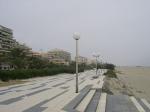
Fitou
- Thème : Sciences and discovery
- Départ : Fitou
- Durée : 2 jours
Fitou is a commune located in the department of Aude in the region of Languedoc-Roussillon.

